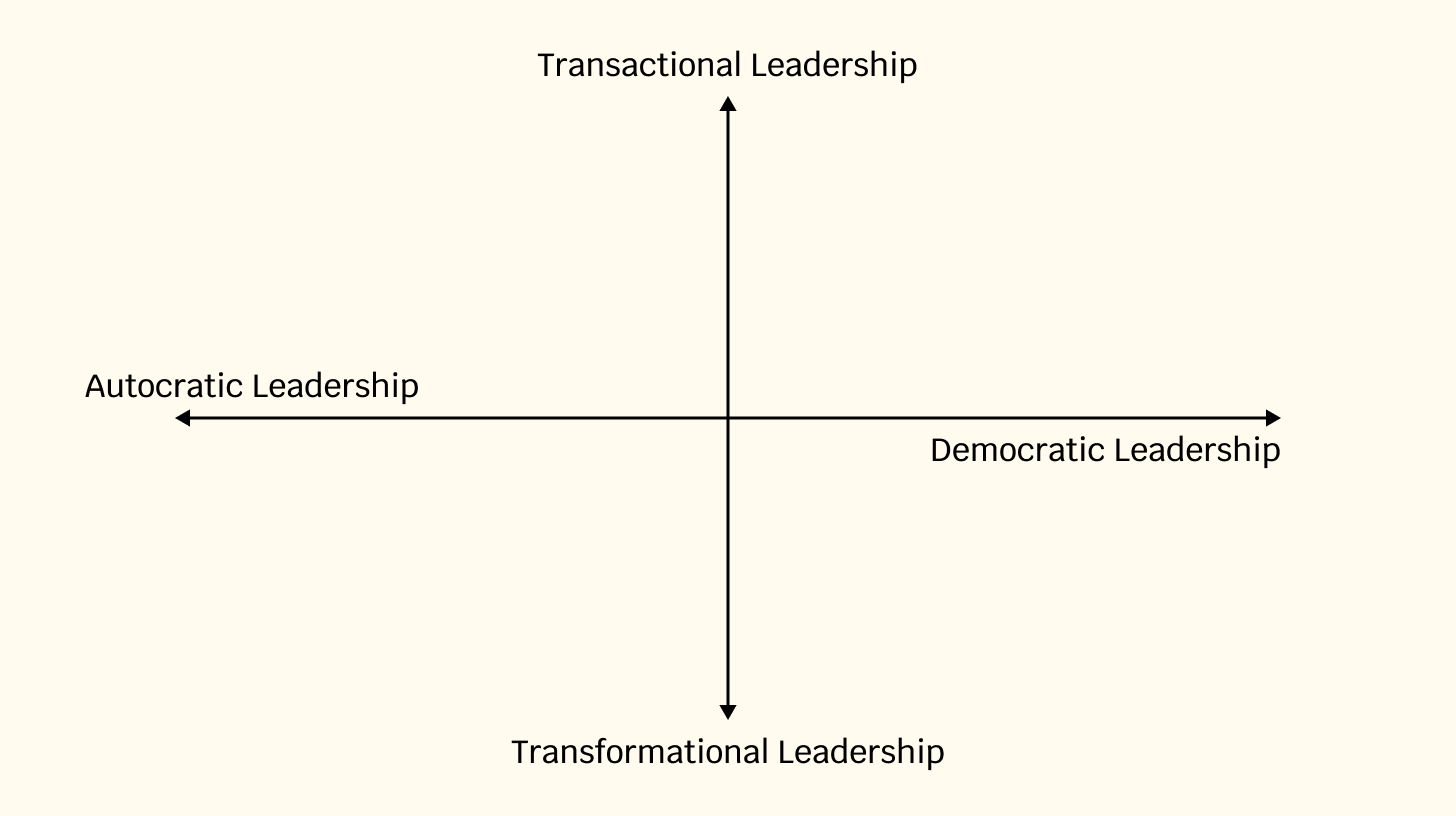Let’s dive into what exactly transactional leadership entails, its advantages, and where it might have its limitations. Ready to explore and see if this leadership model resonates with you?
What Is Transactional Leadership?
Transactional leadership operates on the principle of exchange. It involves rewarding employees for good performance and applying punishment or corrective feedback for underperformance. Picture a leader who sets clear expectations, a team with precise goals, and consequences or rewards delivered based on performance levels.
While transactional leaders may differ from visionary trailblazers, they excel as efficient managers ensuring smooth day-to-day operations. They prioritize short-term objectives, rewarding team members for meeting targets and providing corrective feedback when performance falls short.
Transactional leadership is particularly effective in settings like a sales team, where rules are clear, specific quotas are set, and bonuses await those who exceed expectations. It’s all about keeping the operations running seamlessly and ensuring each team member contributes effectively.
Characteristics of Transactional Leaders
Transactional leaders exhibit distinctive traits that set them apart. If you’re in a leadership role, consider which characteristics resonate with your style and which may not align with your approach:
- Task Focus: Transactional leaders prioritize task completion, setting clear expectations for their team members. They value efficiency and productivity, leading to significant project success 1.
- Use of Rewards and Punishments: Employing a system of rewards and punishments, transactional leaders motivate their team. Achieving goals may result in bonuses, while falling short could lead to consequences like losing a sales client.
- Structured Approach: Transactional leaders prefer structured environments with established rules, procedures, and well-defined roles. They thrive in organized, hierarchical relationships.
- Short-Term Orientation: These leaders often focus on immediate tasks rather than long-term strategic objectives. Their goal is to get the job done efficiently, which may sometimes limit innovation.
- Limited Employee Autonomy: Transactional leaders typically restrict the level of autonomy granted to employees. Decision-making is centralized with the leader, expecting team members to follow instructions rather than initiate action.
In essence, a transactional leader views their team as a well-oiled machine, with clear inputs leading to predictable outputs.
Pros and Cons of Transactional Leadership
Transactional leadership, like any leadership style, comes with its own set of advantages and drawbacks. Whether it is the right fit depends on the industry, team, and specific circumstances. If you’re in a leadership position, it’s essential to weigh the pros and cons to determine the suitability of transactional leadership for your situation.
Advantages of transactional leadership
Advantages of transactional leadership include efficiency and productivity as it emphasizes clear roles, tasks, and reward systems. A key aspect of this style is providing clear expectations and a direct path to success for team members, reducing stress and confusion in the workplace.
Additionally, transactional leadership excels in large organizations where established procedures and hierarchical structures are crucial, ensuring consistency and structure. Its ease of implementation, operating on well-established principles of reward and punishment, makes it a preferable choice compared to more complex and nuanced leadership styles. These advantages position transactional leadership effectively in scenarios where clarity, efficiency, and structure are essential components of success.
Contexts where transactional leadership is most useful
Transactional leadership is most effective in situations where tasks are routine, goals are clearly defined, and there’s minimal need for innovation.
Common examples of environments where transactional leadership excels include manufacturing, sales-oriented businesses, and military organizations. Additionally, it proves useful during crises or situations where strict compliance with rules and procedures is necessary. In such contexts, the emphasis on clear expectations, structured processes, and reward systems aligns well with the demands of the tasks at hand.
Disadvantages of transactional leadership
Transactional leadership has its share of drawbacks that are essential to consider. One major concern is the hindrance it poses to innovation. The emphasis on maintaining the status quo and accomplishing specific tasks can stifle creativity and impede the flow of innovative ideas within a team or organization.
Another drawback is the short-term focus inherent in transactional leadership. While it efficiently addresses immediate goals, there is a risk of overlooking the significance of long-term objectives and strategic planning. This myopic approach may necessitate a greater emphasis on visionary leadership to ensure future success.
Moreover, the success of transactional leadership heavily relies on the capabilities and effectiveness of the leader. In instances where tasks and rewards are not clearly defined, the entire process may suffer. A meta-study 2 highlights that transactional leadership tends to disempower employees, emphasizing the importance of clear communication and guidance from the leader.
Employee dissatisfaction is another critical issue associated with transactional leadership. While clear expectations and rewards can serve as motivators, the lack of autonomy and the punitive approach towards mistakes may lead to discontent among employees and contribute to high turnover rates.
Considering specific contexts, transactional leadership may find limited utility in creative industries, start-ups, or any environment that places a premium on innovation and long-term strategic planning. Its effectiveness diminishes when team members are expected to take initiative and make independent decisions.
Furthermore, transactional leadership may not be the most suitable approach in fostering a positive, collaborative team culture, which is often crucial for success. In industries where employees value a fun, balanced work culture and collaboration is key, other leadership styles may prove more effective.
In summary, while transactional leadership has its merits in certain situations, its limitations in terms of innovation, long-term planning, dependence on the leader, and potential for employee dissatisfaction must be carefully considered. The choice of leadership style should align with the specific needs and characteristics of the team and organizational context.
Transactional Leadership
Transactional leadership relies on clear tasks, expectations, and rewards as its primary mechanisms. It focuses on maintaining the status quo and accomplishing specific tasks efficiently. In contrast to transformational leadership, which emphasizes inspiration and a shared vision, transactional leaders are more concerned with the day-to-day operations and ensuring that predefined goals are met.
Transformational Leadership
Transformational leaders, on the other hand, prioritize inspiration and motivation. They connect team members to a broader purpose, fostering a supportive environment that encourages creativity and innovation. Personal development is a key focus, aiming to elevate individuals and the organization as a whole. A notable example is Satya Nadella, the CEO of Microsoft, who transformed the company’s culture by inspiring a “growth mindset” and steering it towards cloud computing and collaboration tools.
These leadership styles are often seen as residing on different ends of the spectrum. While transactional leadership is pragmatic and task-oriented, transformational leadership is visionary and seeks to bring about significant organizational change. Research (ref 3) suggests that different cultures may exhibit preferences for one style over the other, further highlighting the contextual nature of leadership effectiveness.
Understanding the nuances between transactional and transformational leadership allows organizations to strategically choose the approach that aligns with their goals, culture, and the nature of their tasks. Each style brings unique strengths to the leadership spectrum, catering to diverse organizational needs 3.
Transactional leadership and autocratic leadership represent distinct styles in organizational leadership.
Autocratic leadership involves leaders making unilateral decisions with minimal input from their team members, establishing a clear chain of command where directives are expected to be followed without extensive consultation (source). Consider Anna Wintour, the longstanding editor-in-chief of Vogue, as an example. In this role, she exercises decisive editorial and managerial choices, shaping the magazine’s tone and direction with a strong, singular vision (source).
Autocratic leaders prioritize control and authority in their decision-making processes, creating a structured environment where commands are to be executed promptly. On the other hand, transactional leaders operate with a focus on a structured system of rewards and punishments to drive performance (source).
It’s noteworthy that these leadership styles are not necessarily contradictory. A leader has the potential to embody traits of both transactional and autocratic leadership or align more closely with one style than the other (source). The distinction lies in the leader’s approach to decision-making, motivation, and the extent of team involvement in the process.
Transactional leadership vs. democratic leadership
Democratic leadership stands in opposition to autocratic leadership, emphasizing active involvement of team members in the decision-making process. This collaborative approach fosters a culture of collaboration, shared responsibility, and collective ownership of outcomes (source). Notable leaders who embody democratic leadership include those who actively engage their teams in decision-making.
On the other hand, transactional leadership focuses less on shared decisions and more on providing clear directives and feedback. It operates within a structured system of tasks, expectations, rewards, and consequences, with an emphasis on task completion and efficiency (source).
Consider Howard Schultz, the former CEO of Starbucks, as an example of a leader who integrates democratic elements into his leadership style. Schultz frequently involved employees in decision-making processes, such as determining benefits packages and social responsibility initiatives (source).
Importantly, a leader is not confined to one style exclusively. A leader can exhibit traits of both transactional and democratic leadership or align more closely with one style than the other (source). The distinction lies in the leader’s approach to decision-making, with democratic leaders prioritizing team involvement and transactional leaders relying on structured directives and feedback to drive performance.
Leadership quadrants
To gain a visual understanding of various leadership styles, envision each on a quadrant axis, providing a nuanced perspective on leadership dynamics. Let’s explore examples within these leadership quadrants:

Transactional & Autocratic: Martha Stewart exemplifies leadership in the top-left quadrant. Her leadership style is marked by a clear vision and a firm control over decision-making. Stewart’s emphasis on precision and high standards aligns with the transactional aspect of this quadrant.
Transactional & Democratic: In the top-right quadrant, Herb Kelleher, co-founder of Southwest Airlines, serves as an example. Kelleher is renowned for his participative management style, actively involving team members in decision-making processes while concurrently emphasizing the importance of an efficient operation.
Transformational & Autocratic: The bottom-left quadrant could be represented by Steve Jobs. While Jobs was known for his autocratic decision-making, his ability to inspire and drive innovation within Apple reflects the transformational aspect. Jobs’s leadership style is characterized by visionary leadership and a focus on pushing boundaries.
Transformational & Democratic: In the bottom-right quadrant, consider Richard Branson, the founder of the Virgin Group. Branson is recognized for his democratic leadership style, fostering an inclusive environment where team members are actively involved in decision-making. His ability to inspire and bring out the best in employees aligns with the transformational aspect of this quadrant.

By placing leaders within these quadrants, we gain a holistic view of how their leadership styles intersect with transactional or transformational approaches, as well as autocratic or democratic tendencies. This framework allows for a nuanced understanding of leadership dynamics and the diverse ways in which leaders navigate their roles.
Transactional leadership vs. servant leadership
Servant leadership revolves around the empowerment and service of the team, placing a high priority on their long-term growth and well-being. The central concept is that the leader’s role is ultimately to serve the team and its individual members.
An exemplary embodiment of servant leadership is Mother Teresa, a deeply revered figure who devoted her life to serving the poor and sick, prioritizing their well-being above organizational or personal gain.
On the flip side, transactional leadership shifts the focus away from empowering team members and leans more towards achieving clear objectives and rewards, thriving in structured, goal-oriented environments.
While servant leaders find fulfillment in fostering the flourishing of team members, transactional leaders operate on a quid pro quo basis, clearly outlining the actions team members must take to earn rewards.
History of Transactional Leadership
Transactional leadership traces its roots back to the early 20th century, coinciding with the ascent of classical management theory 4. This leadership style was characterized by three key features:
- Distinct hierarchical layers, establishing three levels of responsibility spanning from leaders to subordinates.
- Contingent reward, rooted in the belief that employees are primarily motivated by incentives, akin to viewing people as functioning like machines whose output is influenced by rewards.
- A workplace analogy of an assembly line, where “large tasks are broken down into smaller ones that are easy to accomplish. Workers understand their roles and typically specialize in a single area. This helps increase productivity and efficiency while eliminating the need for employees to multi-task,” as explained by educators at Villanova University.
Originating from the industrial age, this leadership philosophy perceives employees as components within an assembly-lined machine.
Major contributors to transactional leadership theory include Max Weber and Frederick Taylor 5. Max Weber, a sociologist, delved into bureaucracy, emphasizing the importance of clear structures and rules. In contrast, Frederick Taylor’s scientific management theory focused on task optimization and the implementation of appropriate rewards.
Frequently Asked Questions About Transactional Leadership
What is transactional leadership?
Transactional leadership is a managerial approach wherein leaders encourage compliance among their team members by utilizing rewards and punishments. This style is highly focused on tasks, setting clear expectations, and achieving short-term goals.
What is the difference between transactional and transformational leadership?
The primary distinction between transactional and transformational leadership styles lies in their approaches. While transactional leaders motivate through rewards and punishments, transformational leaders inspire their teams toward a shared vision, fostering innovation and personal development.
What are examples of transactional leadership?
Examples of transactional leadership can be observed in various sectors, including military organizations where obedience is paramount, sales teams with clear target-setting and reward structures, or manufacturing industries characterized by routine tasks, stability, and strict adherence to procedures. However, this style tends to be less effective in fields centered around innovation and intellectual stimulation.
Takeaways on Transactional Leadership
Transformational leadership stands out among various leadership approaches, with leaders of this style placing value on:
– Productivity
– Structure
– Efficiency
– Clear expectations
As a result, transactional leadership proves effective in industries like high-performance sales or the military, especially during times when a team requires a tight focus on short-term goals.
However, transactional leadership tends to have limitations, including:
– Not fostering innovation
– Deterring focus from long-term vision
– Overreliance on the leader
– Dissatisfaction among employees
If your goal is to establish a company that emphasizes inspiration, innovation, and self-motivated employees, it might be worthwhile to explore alternative leadership styles.
Best of luck on your leadership journey, regardless of the approach you choose. If you’re interested in a different perspective on leadership, particularly strengths-based leadership and building a strengths-based team, this PRODUCT MARKET FIT is right up your alley.
- https://www.sciencedirect.com/science/article/pii/S1877050916323584
- https://journals.sagepub.com/doi/10.1177/0149206320908646
- https://www.diva-portal.org/smash/get/diva2:230525/fulltext01.pdf
- https://www.villanovau.com/resources/leadership/classical-management-theory/#:~:text=The%20classical%20management%20theory%20involves,specialize%20in%20a%20single%20area.
- https://harappa.education/harappa-diaries/max-weber-theory-of-bureaucracy-2/



